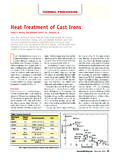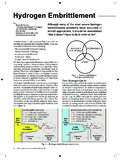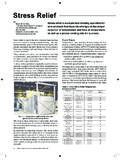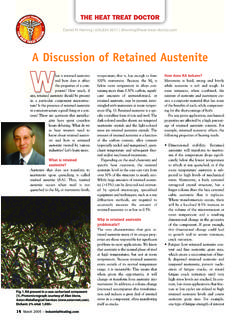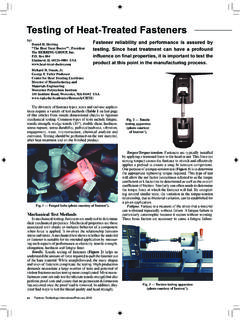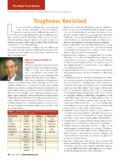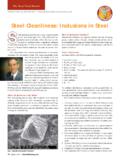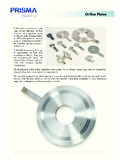Transcription of Practical Considerations for Successful Hardness Testing
1 - April 2006 83 Hardness Testing is one of the most common quality control checks performed. It is often used to determine the success or failure of a particular heat treatment operation or to understand the material s current condition. Hardness test-ing is one of the easiest tests to perform on the shop fl oor or in the laboratory, but it can be one of the hardest tests to do properly. Hardness is a property determined by measuring the resistance to deformation from an applied load. Alignment of the indenter to the sample surface is crucial to correct Hardness measurements.
2 The penetration is measured by either depth or area, which is then translated into a hard-ness number. It is important to realize that all conventional Hardness - Testing methods involve sampling some volume of material. The amount of material actually sampled is a function of the indenter selected, the ap-plied load and the material properties. If the sampled volume is limited by the physical size of the piece to be tested, then you may actually be sampling the underlying anvil or pushing out beyond the edge of the sample. The most commonly used indentation Hardness tests are the Brinell, Rockwell, Rockwell Superfi cial and microhardness methods.
3 The Brinell test is used primarily for inhomogeneous materials such as forgings and castings, particularly cast iron. The Rockwell test (Table 1) is used for both ferrous and nonferrous materials, which have been annealed, hardened, case hardened or tempered. Sheet materials in heavier gages and cemented carbides can also be tested. Rockwell Superfi cial is used where lighter loads are required for Testing thin case hardened surfaces , decarburized layers and sheet material in thin gages. Microhardness tests are typically used for very small, intricate shapes, thin parts and for case depth determination.
4 Types of Indenters & Test MethodsBrinell Testing uses larger indenters ( 10 mm) and heavier loads ( 3000 kg) to minimize localized feature effects such as graphite fl akes or voids in castings. Common indenters for Rockwell Testing include diamonds and steel or carbide balls (although steel is being phased out). Applied Testing loads range from 15kg for the Rockwell superfi cial scales to 150kg for the C scale. To illustrate the concepts of Hardness Testing , imagine a pen being pushed into a small cubic chunk of clay and then retracted (Figs. 1, 2, 3). You are left with a hole where depth is dependent on the force applied load and the resistance of the Practical Considerations for Successful Hardness TestingBy Alan Stone, Aston Metallurgical Services, Inc.
5 , and Daniel H. Herring, The HERRING GROUP, knows how to perform a Hardness test, or do they? Hardness Testing is made more complex by such real world factors as a hard case over a soft core, hard particles, soft inclusions, and soft layers over hard cores to name a few. Part size, shape, and weight are other test challenges. Selection of the best test method, use of proper procedures, and a keen awareness of what and where to test are Testing & CharacterizationHHFig. 1. Large Pen Indenter Applying Initial Load into Clay Cube. Fig. 2. Large Pen Indenter Applying Intermediate Load into Clay Cube. Fig. 3. Large Pen Indenter Applying Excessive Load Bulging Sides of Clay Cube.
6 Fig. 4. Small Pen Indenter Applying Load to Clay Cube with Minimal Side DistortionFig. 1 Fig. 2 Fig. 3 Fig. 484 April 2006 - to the indentation. A different sized or shaped pen (Fig. 4) produces a different type of indentation. As shown, the heavy loads produce deeper indentations and sample more volume of material. The higher the Hardness of the material, the more resistant it is to penetration and the shallower the resultant indentation. From this explanation, Hardness Testing sounds pretty simple. That is, until you factor in real world Considerations . What happens if there is a hard case ( nitriding, carburizing, and plating) over a soft core?
7 Or a soft layer over a hard core ( decarburization)? Or soft inclusions for machinability? Or hard particles such as carbides? What if the shape is complex and you don t have fl at parallel surfaces ? Or you can t get your indenter to the region of interest? One of the most common problems we see is that the material is too thin, too soft or too irregularly shaped to allow for Rockwell Testing . Another common problem is that the method specifi ed or the individual performing the test fails to account for the three dimensional aspect of the part, and the test does not truly sample the appropriate volume of material.
8 Indenters for microhardness Testing (Fig. 5) include Knoop and Vickers with applied loads ranging from 1 gram to 1000 grams. The indentations are typically measured optically at magnifi cations from 400 to 1000 . High quality optics is critical especially when using magnifi cations of 500 and greater. Accurate measurement of the indentation boundaries, especially when using lighter loads, is mandatory Microhardness Testing is ideal for precise sampling of a small region, for a very thin part (Figs. 6, 7), a soft sample, or a material with either hard or soft particles you wish to include or exclude from the fi eld of measurement.
9 The Knoop and Vickers indenters have different aspect ratios. Knoop indenters are elongated and better suited for more precise measurements of layers or for measurements at specifi c depths. Vickers indenters are more symmetric and better suited for particle Hardness measurements. The key to microhardness Testing is that it requires more sample preparation and operator skill, as well as more elaborate Testing equipment. Unlike Rockwell scales, microhardness numbers are affected by the applied load. For example, a Knoop Hardness value of 100 taken with a 500-gram load (HKN500 100) is not equivalent to a Knoop Hardness value of 100 taken with a 50-gram load (HKN50 100).
10 Hence it is critical to report the applied load along with the test result. It is also important to know that ASTM E140 only recognizes microhardness conversions with minimum loading of 500 grams. Consequently, conversions to Rockwell scales produce errant values at increasingly lighter loads (Fig. 8). Microhardness Testing is sensitive to a Table 1 Typical Rockwell Scale Applications[1]Scale SymbolTypical Application of the ScaleACemented carbides, thin steel and shallow case hardened alloys, soft steels, aluminum alloys, malleable Hard cast irons, pearlitic malleable iron, titanium, deep case hardened steel, and other materials harder than HRB steel and medium case hardened steel and pearlitic malleable ironECast iron, aluminum and magnesium alloys, bearing copper alloys, thin soft sheet bronze, beryllium copper, malleable irons and materials softer than HRG , lead, and , L, M, P, R, S, VBearing materials and other very soft or thin materials.
